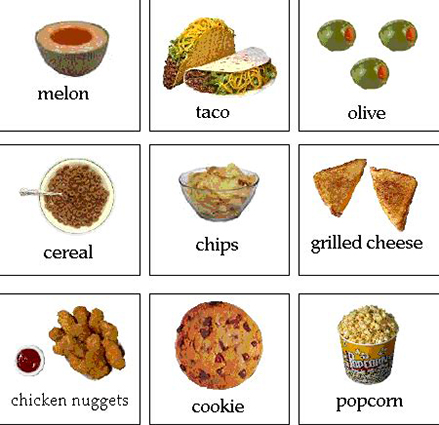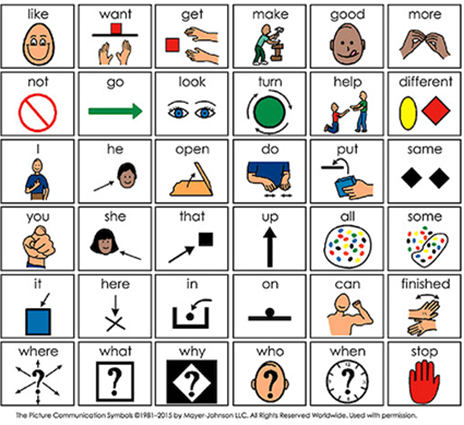Module 4: Augmentative and Alternative Communication
Total Communication—Recognizing All the Ways a Student Communicates
Everyone uses a variety of ways to communicate including words, gestures, facial expressions, and body language. Students with complex needs often use these forms of communication more than spoken words. It is up to us, as their partners in learning, to recognize and honour all the different ways they communicate.
A Personal Communication Dictionary is a tool used to document all the different ways a student communicates. This tool helps everyone to respond consistently to the student.
The goal is always to support a student to communicate effectively. AAC is one strategy that a student uses to communicate. A student can also greet you with a wave or request an object by pointing to it. This is what it means to be a total communicator. It is important to recognize and respond to all the ways a student communicates. It is not necessary to require that they use their AAC system to repeat the same message.
Research helps us understand how we can best support students to become successful communicators. AAC is about enhancing personal communication not replacing it. Responding to a student’s form of communication encourages continued use and further exploration into other forms (low- or high-tech) of communicating, including oral speech. It is important to remember that we all prefer to use the easiest and most efficient way to communicate.
We should not insist on a student using their AAC device to communicate their message if there is another, equally effective way that they are already using.
Honouring communication attempts, no matter what they are, is the best way to support a student’s communicative growth.
Strategies for Effective AAC Use
Modelling is a fundamental teaching strategy for developing communication skills. Students need to see and hear language being used to learn how to use language themselves. This is true for very young children learning to speak, and the same applies to students learning to use AAC.
Model AAC use at every opportunity. Model it in the classroom, in the hallway, outside at recess, with staff and with other students, across the routines of the day.
Modelling means using the same AAC systems as your student when you talk to them.
If your student uses a BIGmack to greet you with the message “hello,” you might also push the BIGmack button as you are greeting the student, saying something like “Hi Cassie, nice to see you!” If your student waves hello, respond by pushing the BIGmack to say “hello” back to them. This allows you to model use of the button while also using a total communication approach.
Modelling teaches a student how to use their AAC system and shows them that the AAC system has a purpose.
Students learn to generalize the use of their communication systems when modelling occurs in natural contexts. Practicing hitting the BIGmack button only on arrival to the classroom in the morning will not generalize its use to greet classmates in the hallway or on the playground. Modelling demonstrates meaningful, functional ways that the AAC system can be used.
Modelling supports others’ awareness of AAC and its purpose.
Seeing AAC in action will help classmates, staff and others in the wider community feel more comfortable interacting with the student who uses AAC. This is a process that will empower students to have their communication acknowledged alongside. When a student interacts using AAC their classmates can see their purposeful participation. Familiarizing everyone with AAC helps the whole community have a richer more inclusive culture.
Remember to practice consent. Always ask the student if it is ok to use their system and wait for them to indicate their consent.
A simple, “Cassie, I’m going to press your BIGmack. Is that ok?” affirms for the student that it is their communication system, and that they have control over who uses it.
The more often a student has access to an AAC system, the more likely they are to see the system as purposeful and the more likely they are to start to use that system themselves.
Successful AAC use requires:
- AAC system is always with the student
- Positioning and access strategies have been determined and are in place
- Vocabulary is current and meaningful to the student
- High tech AAC systems are charged and ready for use
- Staff are trained in general strategies to support AAC use and also in strategies specific to the student they support
- Having a back-up system available for use (e.g., screen shots of vocabulary on a high-tech system or an extra set of picture cards available). Batteries run out, things get lost or misplaced, and the student will need access to communication

Watch the following video of a student being supported to use their AAC device to greet an adult in the hall.
How did the adult respond? Think about how the supported use of AAC helped this student to be respected and perceived as a communicator.
It is important that the classroom teacher, educational assistant, SLP, and family work together to decide the messages and vocabulary a student needs on their AAC system. Focus on vocabulary that will be meaningful and relevant.
When choosing vocabulary for an AAC system, select a balance of core and fringe vocabulary.
Core vocabulary is a small set of words used frequently in many settings:
- 80% of what is said
- Basic needs, social exchanges, high use words. Examples include: “I” “mine” “yes” “stop” “all done” “what?”
Fringe vocabulary are words used in specific settings or for a specific topic and are used less frequently:
- 20% of what is said
- Help with curriculum-specific words. Examples include: “strawberries” “steel”
When choosing messages a student might want to say, it can be tempting to focus on fringe vocabulary, or things (such as cookie, bathroom). Fringe vocabulary usually consists of nouns, which are easier to represent with a picture. Fringe vocabulary alone will only allow a student to communicate for a limited number of purposes, such as to request (“I want a cookie”) or to label (“that’s a cookie”).
Core vocabulary allows a student to:
- Communicate for a wider variety of purposes. Providing a student with core words allows for multiple opportunities for adults to model their use across the day, as well as for the students to use the words themselves
- Request, label, protest, ask questions, start a conversation, greet others, share their opinion and more. Providing vocabulary that can be used for a variety of purposes builds the meaningfulness of AAC for students
The more opportunities a student can use an AAC system across their day, the more likely they will see it as functional and be motivated to use it.


Students learn language in different ways. Some students can learn to communicate by understanding single words and how to combine these to make longer sentences. Other students benefit from preprogrammed sentences in high-tech AAC systems. These word combinations are stored as a “whole” under one location button on the AAC and students learn how and when to use these by seeing and hearing them used in interactions.
Preprogrammed phrases can help students maintain the conversational flow because with one “hit” they can express a whole question or response. For example, if a student can say “can I play with you?” with one tap this will take less time and energy than locating three picture symbols.
Preprogrammed sentences are also helpful because they make it quick and easy to initiate conversations. Having a BIGmack or TapSpeak Sequence app programmed with the sentence “Hey! Do you want to hear a joke?” is more likely to get a peer’s attention than the single word “Joke.” In this way, preprogrammed phrases can be helpful for building inclusion in classroom activities.
You will want to carefully consider what are the most meaningful, purposeful sentences that can be used across multiple settings, when collaborating with your SLP and team to build preprogrammed sentences for a student.
We all learn through practice and exposure, and AAC is no different. Spending time touching and exploring is part of the process of learning and understanding a communication system.
Students need time to explore their AAC systems, free from any expectations or pressures to use the system functionally. Find time every day where the student can be given access to their communication system and do whatever they want with it. Exploration is how students develop their familiarity and comfort with a system. Try to set the student up for success by letting them know that this is their time to explore.
With the student’s consent, classmates benefit from opportunities to engage with AAC systems. This develops familiarity with how their classmate communicates and destigmatizes the use of AAC. Consider building a lesson around the ways we all communicate as part of a Language Arts class. Offer peers the opportunity to play with the AAC systems being used in your school. Build opportunities for peers to use a parallel AAC system during whole class activities. For example, set up a literacy center where students can explore AAC systems connected to reading.
When we offer opportunities for all students to engage with AAC systems, it can have a significant positive impact on inclusion.
Long before they can spell and write, children are given the opportunity to engage with print and writing through scribbling and drawing.
The first step in building these writing skills is providing access to the alphabet. For example, this can be done through interaction with magnetic letters, a paper-based letter board, or a keyboard feature on a high tech AAC device (also referred to as an alternative pencil). Think of their access to these systems as the AAC version of scribbling. It is important to attribute meaning to their writing based on their stage of emergent literacy. Exploration and play with these tools are part of the learning process. It is not always necessary to have a clear spelling or literacy activity for students to benefit from the exposure to alphabet systems.